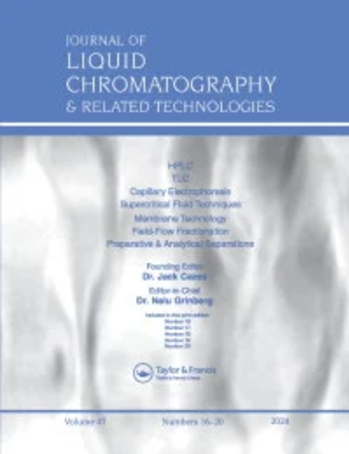Streamlined stationary phase selection facilitated by a “sample-plug retention test” in supercritical fluid extraction-supercritical fluid chromatography-mass spectroscopy (SFE-SFC-MS) method development for on-line extraction of anabolic agents
IF 1
4区 化学
Q4 BIOCHEMICAL RESEARCH METHODS
Journal of Liquid Chromatography & Related Technologies
Pub Date : 2021-12-14
DOI:10.1080/10826076.2022.2098319
引用次数: 3
Abstract
Abstract A novel method development (MD) approach was established to aid column selection for online supercritical fluid extraction-supercritical fluid chromatography-mass spectrometry (SFE-SFC-MS). An adapted stationary phase (SP) selection procedure was used to expand traditional SFC-MS screening by inclusion of an “Analyte-Plug Retention Test.” This test enabled an early evaluation of “trapping” capability for a plug of targeted analytes on the SP. Using an SFE-simulation method, the on-line trapping of an SFE-based extract-plug was mimicked by trapping an SFC-based injection-plug under instrument conditions similar to an actual on-line extraction. Thirteen SPs were screened using the adapted MD procedure as part of the SFC-separation optimization in the development of an on-line SFE-SFC-MS extraction method for anabolic agents (AAS) in anti-doping testing. A cyano SP was chosen for further development, based on chromatographic separation potential and high plug-retention potential for targeted analytes. The chosen column was used in “proof-of-concept” on-line extractions using a generic SFE-SFC-MS method. Successful extract-plug trapping was demonstrated. Retention times and peak areas (4–20%RSD) were reproducible for targeted AAS. Successful first round SFE-SFC-MS SP selection was demonstrated to circumvent tedious re-optimization in future development stages and streamlining of the hyphenated SFE-SFC-MS MD process. Graphical Abstract在超临界流体萃取-超临界流体色谱-质谱(SFE-SFC-MS)在线提取合成代谢剂的方法开发中,通过“样品塞保留试验”简化了固定相选择
摘要建立了在线超临界流体萃取-超临界流体色谱-质谱(SFE-SFC-MS)色谱柱选择的方法开发方法。采用改良的固定相(SP)选择程序,通过加入“分析塞保留测试”来扩展传统的SFC-MS筛选。该测试能够对SP上目标分析物桥塞的“捕获”能力进行早期评估。使用sfe模拟方法,在类似于实际在线提取的仪器条件下,通过捕获sfc注入桥塞来模拟基于sfe的提取桥塞的在线捕获。在开发用于反兴奋剂检测的合成代谢剂(AAS)的SFE-SFC-MS在线提取方法的过程中,采用改进的MD程序筛选了13种SPs,作为sfc分离优化的一部分。基于对目标分析物的色谱分离潜力和高plug-retention电位,选择了氰基SP进行进一步开发。选择的色谱柱使用通用的SFE-SFC-MS方法进行“概念验证”在线提取。成功地证明了提取塞捕获。保留时间和峰面积(4 ~ 20% rsd)可重复性好。成功的第一轮SFE-SFC-MS SP选择被证明可以避免在未来开发阶段繁琐的重新优化和简化连字符SFE-SFC-MS MD过程。图形抽象
本文章由计算机程序翻译,如有差异,请以英文原文为准。
求助全文
约1分钟内获得全文
求助全文
来源期刊
CiteScore
2.80
自引率
0.00%
发文量
29
审稿时长
4.9 months
期刊介绍:
The Journal of Liquid Chromatography & Related Technologies is an internationally acclaimed forum for fast publication of critical, peer reviewed manuscripts dealing with analytical, preparative and process scale liquid chromatography and all of its related technologies, including TLC, capillary electrophoresis, capillary electrochromatography, supercritical fluid chromatography and extraction, field-flow technologies, affinity, and much more. New separation methodologies are added when they are developed. Papers dealing with research and development results, as well as critical reviews of important technologies, are published in the Journal.

 求助内容:
求助内容: 应助结果提醒方式:
应助结果提醒方式:


